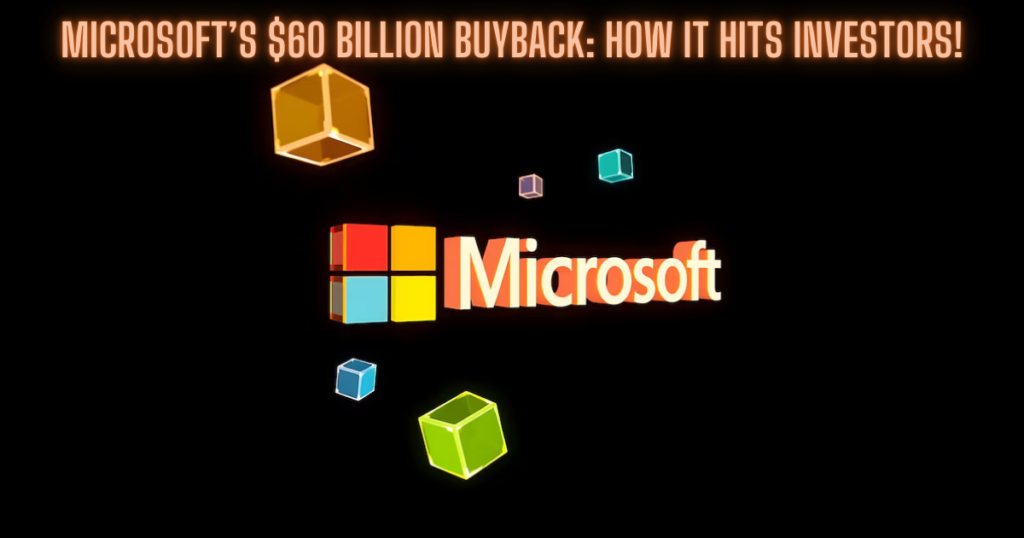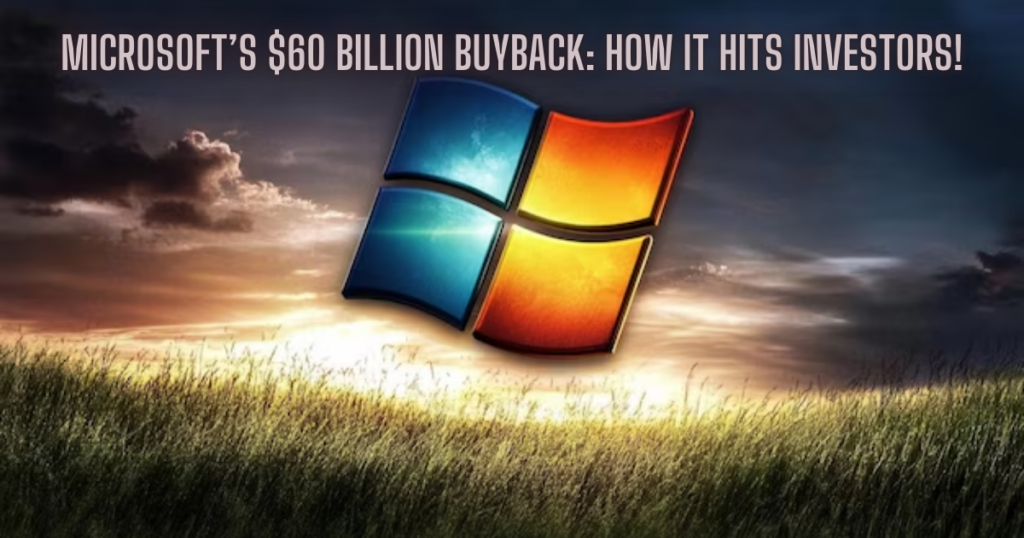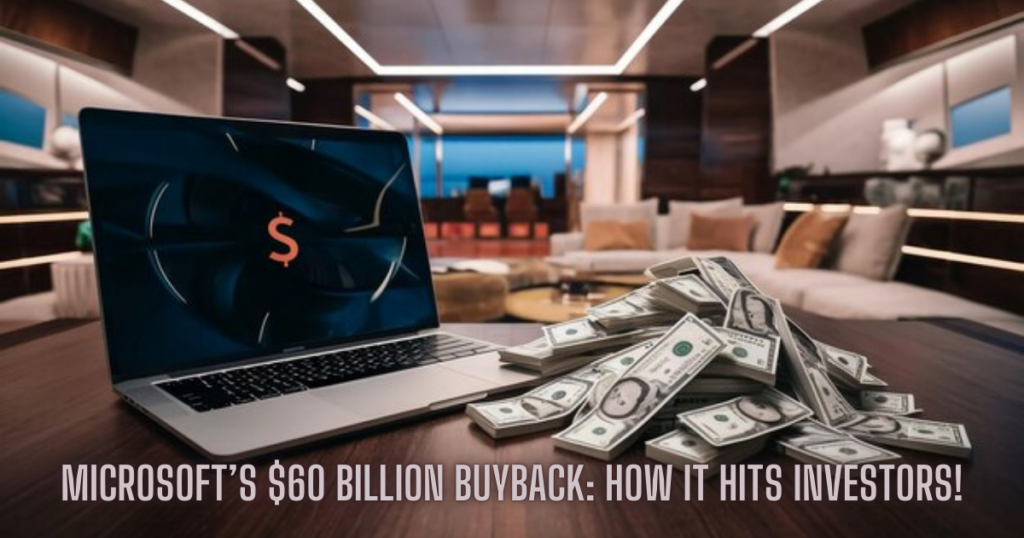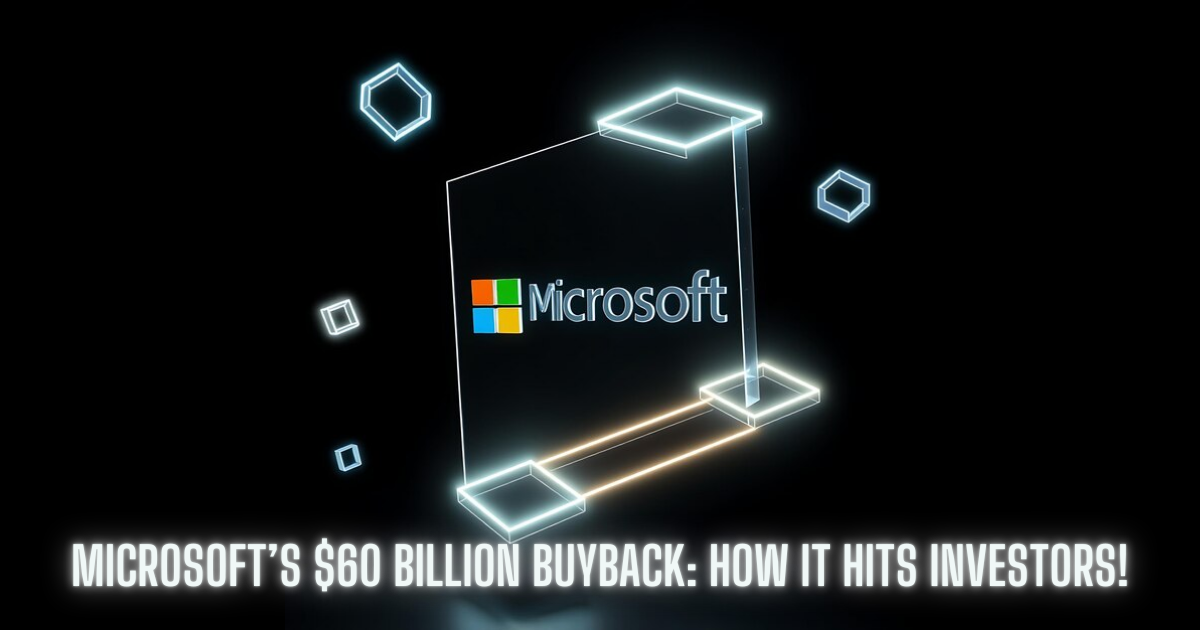Microsoft’s $60 Billion Buyback-Microsoft recently announced a new $60 billion share buyback program. This decision has caught the attention of investors and analysts. A share buyback is when a company repurchases its own stock from the market. It’s seen as a way to return value to shareholders, and in this case, it’s a major move by Microsoft.

- What is a Share Buyback?
- Why is Microsoft Buying Back Shares?
- Impacts of Microsoft’s $60 Billion Buyback Program
- Stock Prices Could Surge
- Impact on Microsoft’s Financial Statements-Microsoft’s $60 Billion Buyback
- Will Buybacks Continue?
- Potential Risks
- Conclusion-Microsoft’s $60 Billion Buyback
- Final Thoughts-Microsoft’s $60 Billion Buyback
- Disclaimer
What is a Share Buyback?
A share buyback lowers the number of shares available in the market. As a result it enhances the value of the balance shares. Companies usually do this when they believe their shares are undervalued or have extra cash on hand. Microsoft has been very successful financially, so they are choosing to buy back a large amount of stock.
Why is Microsoft Buying Back Shares?
The focus keyword, Microsoft’s $60 billion share buyback program, shows the company’s confidence in its future. The buyback suggests that Microsoft believes its stock is worth investing in. There are also other factors also behind this move:
Boosting Share Prices: When a company buys back its shares, the supply decreases. This can push up the price. Investors who hold shares can benefit from this rise in value.
Returning Value to Shareholders: Shareholders benefit from buybacks because the reduced supply can mean higher dividends or better stock value. Microsoft has a strong track record of rewarding its investors.
Optimizing Use of Cash: Microsoft has huge cash reserves. By approving this buyback, they are putting their money to work in a way that benefits both the company and investors.
Market Signal: A buyback can signal to the market that the company’s leadership has confidence in its financial health and growth prospects.
Impacts of Microsoft’s $60 Billion Buyback Program

The $60 billion buyback is one of the largest in recent times. See below how it could impact different stakeholders:
| Stakeholder Group | Impact |
| Shareholders | Potential for stock price increases, more value per share held. |
| Investors | Increased confidence in Microsoft’s future; more attractive investment. |
| Market Analysts | Indicates strong financial health and confidence in future growth. |
| Microsoft Itself | Consolidates ownership and reduces dilution of shares. |
Stock Prices Could Surge
One of the primary impacts of a huge buyback program like this is the potential rise in stock price. With fewer shares available, investors may find that their current holdings increase in value. This is especially important for long-term investors. Microsoft’s stock has already been performing well, and this buyback could push it even higher.
Quotes from Analysts
Industry analysts are already weighing in on this development. Here are a few quotes from prominent voices:
“Microsoft’s buyback is a clear signal of their confidence in maintaining growth over the next few years,” says D. K. Sharma, a financial analyst
“This program could significantly improve the stock’s performance in the near term, making it a win for current shareholders,” A senior equity analyst.

Impact on Microsoft’s Financial Statements-Microsoft’s $60 Billion Buyback
Buybacks directly affect a company’s balance sheet and other financials. Here’s how:
| Financial Aspect | Effect of Buyback |
| Cash Reserves | $60 billion will be deducted, reducing available cash. |
| Earnings Per Share (EPS) | The reduced number of shares increases EPS, making the company look more profitable. |
| Shareholder Equity | Reduces the total equity but can improve return on equity (ROE). |
Will Buybacks Continue?
This isn’t the first time Microsoft has engaged in a buyback program. It is part of a broader strategy by the company to manage its financial health. Over the years, Microsoft has regularly returned money to its investors through dividends and buybacks. As long as the company continues to generate massive profits, it’s likely these programs will continue.
Potential Risks
While buybacks can be great for investors, they aren’t without risks:
Overvaluation: Some critics argue that companies might be overpaying for their shares. If Microsoft’s stock is already highly priced, buying it back may not provide the best return.
Opportunity Cost: The $60 billion used for this program could have been invested in research, development, or acquisitions. This could impact Microsoft’s long-term innovation.
Temporary Boost: While buybacks often raise stock prices, the effect can be temporary. Some analysts argue that the long-term value may not change significantly.
Conclusion-Microsoft’s $60 Billion Buyback
Microsoft’s $60 billion share buyback program is a major financial move. It reflects confidence in the company’s future and promises potential rewards for shareholders. While the decision comes with some risks, it shows how Microsoft continues to balance returning value to investors with its growth strategy.
This buyback is not just about increasing stock value, but also about demonstrating that Microsoft has the financial strength to make such bold moves. Investors and analysts alike will be watching closely to see how this impacts the stock market and Microsoft’s long-term prospects.
Final Thoughts-Microsoft’s $60 Billion Buyback
Microsoft’s decision to approve this massive buyback is an exciting development. For shareholders, it’s a positive sign that the company is looking to maximize their returns. However, like any financial strategy, it must be watched closely to ensure it brings the desired benefits.
Table Summary: Financial Impact of the $60 Billion Buyback
| Impact Area | Positive Outcome | Potential Risks |
| Stock Price | Potential for increase in stock value | Could be temporary |
| Earnings Per Share | Higher EPS, makes company look better | Stock price may not reflect true long-term value |
| Cash Reserves | Optimizes excess cash | Limits ability to invest in other growth avenues |
This is a significant development, and investors will need to follow how this buyback plays out in the market.
Disclaimer
This article relies on internal data, publicly available information, and other reliable sources. It may also include the authors’ personal views. However, it’s essential to note that the information is for general, educational, and awareness purposes only—it doesn’t disclose every material fact. This analysis is for informational purposes only and does not constitute financial advice. Consult a professional before making investment decisions.
We publish information on World Virtual CFO in good faith, solely for general information. World Virtual CFO doesn’t guarantee the completeness, reliability, or accuracy of this information. These are our views for informational purposes. When you use our website, know that any action you take is entirely at your own risk. World Virtual CFO won’t be liable for any losses or damages connected to your use of our website. For detailed information, refer to our disclaimer page.
Dr. Dinesh Sharma is an award-winning CFO and AI strategist with over two decades of experience in financial leadership, digital transformation, and business optimization. As the founder of multiple niche platforms—including WorldVirtualCFO.com—he empowers professionals and organizations with strategic insights, system structuring, and innovative tools for sustainable growth. His blogs and e-books blend precision with vision, making complex financial and technological concepts accessible and actionable.
